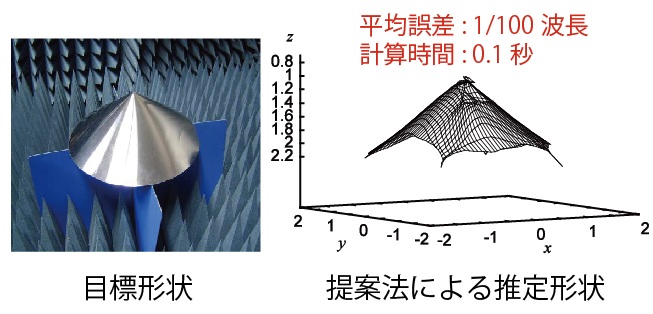Radar Group
High-speed ultra-wideband radar imaging
High-speed ultra-wideband (UWB) radar imaging has been of great interest. SEABED method is one of such promising methods, and can estimate target shapes quickly [Sakamoto et al., 2010b], [Cresp et al., 2010]. However, to realize real-time imaging, measurement time as well should be shortened. Bi-static SEABED method has been developed to achieve fast measurement using a multi-static radar with switches [Kidera et al., 2008b]. Another approach, a code-division multiple transmission UWB radar system was proposed, which does not need switches, to achieve even faster measurement [Sakamoto and Sato, 2009b].
Since SEABED method uses derivative operations, it becomes unstable for noisy data. To improve its noise tolerance, an extended version of SEABED, namely Envelope method, was developed [Kidera et al., 2008e], [Saho et al., 2008] which employs envelopes of circles instead of derivative operations. To improve the accuracy of the Envelope method, waveform distortion was suppressed [Kidera et al., 2007]. Then, the Envelope has been further extended to apply to through-the-wall imaging (TWI) [Kidera et al., 2008a], [Kidera et al., 2008d], [Kidera et al., 2009c].
Both the SEABED and Envelope methods require what is called quasi-wavefront (QW) that is a surface obtained by connecting peak points of signals. This process is not always easy to realize due to interference of waveforms. Optimization-based QW estimation method was developed to avoid this difficulty [Sakamoto et al., 2008b], [Sakamoto et al., 2008c], [Sakamoto et al., 2008e]. Then, range point migration (RPM) method was developed [Kidera et al., 2008c], [Kidera et al., 2010a], [Kidera et al., 2010b], [Kidera et al., 2010c]. This method does not need QW because it calculates derivatives with distribution functions.
These SEABED-class methods all require large-scale antenna arrays that make the system costly. A simple two-antenna UWB radar imaging system has been proposed for a uniformly moving target [Sakamoto and Sato, 2008a], and applied to experimental data [Sakamoto and Sato, 2008d]. This method was extended to apply to arbitrary translational motion [Sakamoto et al., 2009d], [Matsuki et al., 2010d]. Another approach to reduce the number of antennas was proposed by employing multi-path echoes from environments [Sakamoto and Sato, 2009a]. This method uses only a single antenna, but needs a priori information about the environment. This environment-related information can be estimated without calibration process using the optimization-based method [Sakamoto and Sato, 2010a]. Then, a human body tracking method has been proposed using the same principle [Sakamoto and Sato, 2010c]. Furthermore, this approach makes it possible to image targets in a shadow region [Fujita, 2010], [Kidera et al., 2009a] and [Kidera et al., 2009b]. In addition, some feasibility studies have been conducted to apply these methods to actual human bodies [Sakamoto et al., 2009c], [Saho et al, 2010].

Reference
- T. Sakamoto, A fast algorithm for 3-dimensional imaging with UWB pulse radar systems, IEICE Trans. on Commun., vol.E90-B, No.3, pp.636-644, 2007.